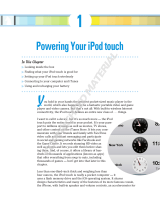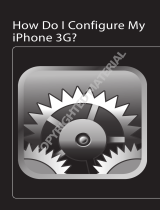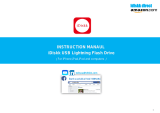
Chapter 2 Getting Started 16
iCloud
If you use the free iCloud account, iCloud stores your content, including music, photos, contacts,
calendars, and supported documents. Content stored in iCloud is wirelessly pushed to your other
iOS devices and computers set up with the same iCloud account.
iCloud is available on an iOS device with iOS 5 or later, on a Mac with OS X Lion v10.7.2 or later,
and on a PC with the iCloud Control Panel for Windows (Windows 7 or Windows 8 is required).
Note: iCloud may not be available in all areas, and iCloud features may vary by area. For more
information, go to www.apple.com/icloud.
iCloud features include:
•
iTunes in the Cloud—Download your previous iTunes music and TV show purchases to
iPod touch for free, anytime. With an iTunes Match subscription, all your music, including music
you’ve imported from CDs or purchased somewhere other than iTunes, appears on all of your
devices and can be downloaded and played, on demand. See iTunes Match on page 56.
•
Apps and Books—Download your previous App Store and iBooks Store purchases to
iPod touch for free, any time.
•
Photos—Use My Photo Stream to push photos you take with your iPod touch to your other
devices, automatically. Use iCloud Photo Sharing to share photos and videos with just the
people you choose, and let them add photos, videos, and comments. See iCloud Photo
Sharing on page 64 and My Photo Stream on page 65.
•
Documents in the Cloud—For iCloud-enabled apps, keep documents and app data up to date
across all your devices.
•
Mail, Contacts, Calendars—Keep your mail contacts, calendars, notes, and reminders up to date
across all your devices. If you use iCloud, don’t also use iTunes to sync your contacts, calendars,
and bookmarks to iPod touch.
•
Backup—Back up iPod touch to iCloud automatically when connected to power and Wi-Fi.
All iCloud data and backups sent over the Internet are encrypted. See Back up iPod touch on
page 138 .
•
Find My iPod—Locate your iPod touch on a map, display a message, play a sound, lock the
screen, or remotely wipe the data. Find My iPod includes Activation Lock, which requires your
Apple ID and password in order to turn o Find My iPod or erase your device. Your Apple ID
and password are also required before anyone can activate your iPod touch. See Find My
iPod touch on page 33.
•
iCloud Tabs—See the webpages you have open on your other iOS devices or computers with
OS X. See Chapter 7, Safari, on page 46.
•
iCloud Keychain—Keep your passwords and credit card information up to date across all your
designated devices. See iCloud Keychain on page 33.
•
Find My Friends—Share your location with people who are important to you. Download the
free app from the App Store.
With iCloud, you get a free mail account and 5 GB of storage for your mail, documents,
and backups. Your purchased music, apps, TV shows, and books don’t count against your
available space.
Sign in or create an iCloud account, and set iCloud options. Go to Settings > iCloud.
Purchase additional iCloud storage. Go to Settings > iCloud > Storage & Backup, then tap
Manage Storage. For information about purchasing iCloud storage, go to help.apple.com/icloud.
























